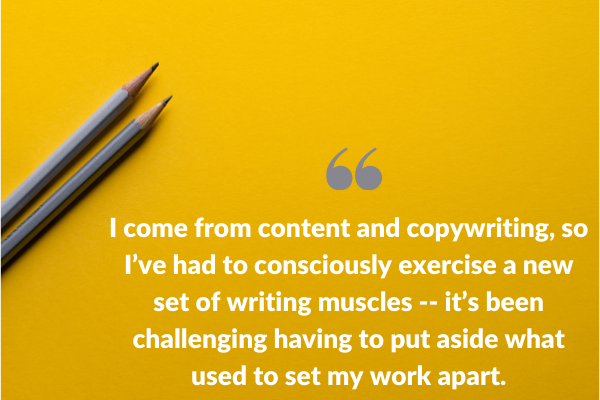UX Writing vs. Content Writing: What’s The Difference?
In this article, I'll define UX writing and compare it with some of the other popular roles within content strategy and product design and hopefully make a successful case as to why you should expand your team’s skill sets or even hire a specialized UX writer for your team.

In the marketing and user experience (UX) space, there tends to be confusion among the specialties of UX writing, content writing, copywriting, and UX design, which are all umbrellaed under the broader categories of content strategy and product design. It’s hard to cut the noise and differentiate the titles of different roles and whether they are just buzzwords or are here to stay.
The roles aforementioned often tend to be intertwined, especially for budding startups who are unable to compensate for an individual managing each specialty, and instead must have the engineer, marketing manager, or product designer write all the copy, from website and app microcopy to product descriptions.
Although economical and straightforward, this may not produce the greatest results as your makeshift UX writer may not possess the wordsmith, or “word nerd” skills that adhere to your unique brand voice while being aware of the usage of technical jargon and adhering to the general UX writing principles of clarity, concision, and usefulness.
Maggie Stanphill, a UX Director at Google, explained how the strategic rephrasing of a single button label increased user engagement significantly.
When a user searched for a hotel on Google previously, there was a label that read “Book a Room.” The content strategy team found this phrase to be too committal for the user in their decision-making process as they were still considering rooms, prices, dates, etc. so the team experimented with the phrase “Check Availability” instead, and found a 17% increase in user engagement. This remarkably subtle change in wording shows the impact quality UX writing can have on your product’s success.
What is UX Writing?
UX writing is all the words, or “microcopy” as we like to call it, you see from the very start to end of using an app or website, spanning from the onboarding instructional steps to the success message after completing your first purchase or publishing your first post. Great UX writing is hardly ever noticed by the user because it is an intuitive, natural-flowing conversation, and resonates and connects with the audience.
Have you ever chuckled after reading a humorous 404 redirect page error message? Or felt guilty after receiving a “We’re sorry to see go” message after unsubscribing from an email list? These are just a few examples of UX writing at play.
The humans behind microcopy work with interdisciplinary teams consisting of engineers, designers, product managers, marketiers, and researchers to strategize brand voice and adjust tone according to context (for example, a success page may have a celebratory and optimistic tone, while a broken internet connection may be more serious), while keeping their language tailored and understandable for their audience, whether they are field specialists or the everyday layman.
Allison Rung, a content strategy manager leading UX writing at Airbnb, stresses how using user-oriented action verbs that have a call-to-action or “next step” for the user, while being mindful of incorporating the right amount of context that makes sense to the user at the moment is important for UX writing that flows.
She admits a common challenge for UX writers is learning the technical specs of the product in order to simplify concepts that a layman can understand. UX writers must map out the user’s journey with the product in order to anticipate and empathize with the user at pain points, which optimizes UX language.
What UX Writing is Not
Marketing or sales. Although UX writers integrate clever copy that aligns with brand principles, they emphasize simplicity and ease for the user and don’t let the creativity of their brand voice take away from the focus of the mission their user is trying to accomplish at the moment.
They do not write promotional copy nor blogs and press releases. UX writers plan for and represent the conversation between your user and product, forecasting and helping users troubleshoot, find information, and navigate to the right place.
They avoid complicating and overwhelming users with unnecessary, flowery language; they’re tactically focused on the task at hand while maintaining the brand’s personality, or the “vibe” that embodies your brand, and when done well, enables readers to personify and relate to your brand, building loyalty, authority, and trust with your users. UX writers must establish brand voice and tone guidelines to be followed by the organization to ensure consistency in all user-facing content produced.
UX Writing vs. Content Writing
Yuval Keshtcher, Founder and CEO of the UX Writing Hub, claims,

UX writers must research their target audience to speak their language and are heavily product-oriented as they work alongside product designers and engineers, while content writers work mostly within a marketing team to highlight the key components of the product’s outcome to showcase it through campaigns that attract users rather than guide through the product.
Yvonne Gando, a senior UX writer at Google, notes that content and copywriters draw prospective customers in at the top promotional part of the funnel, or the acquisition phase, and these leads will later meet with the UX writers when they use your product (if they decide to purchase it).
I suppose you could think of it like a scuba diving excursion where the person handing you the brochure and explaining the trip details is the marketer or content writer, while the person giving you instructions as you gear up with scuba fins, goggles, and snorkel and prepare to dive in is the UX writer.
Many UX writers have a background in content and copywriting. This quote from Rebekah Bek, a content writer turned UX writer at Ahrefs, illustrates the difficulty of transitioning from one to another, inherently due to their different qualities,

UX Writing vs. UX Design
Wireframing, prototyping, user personas, oh my! Although they have their differences, these roles work in parallel, especially for projects such as researching and creating user personas, hypothesizing and running A/B tests, and creating user flow design, which are “the steps from the first task to the next and on until they are done meeting their goal,” as told by Laura Strader, a UX designer at Bluehost.
Good user flow design considers where the customer came from and where they want to go next. The UX designer is focused on the visual elements of the product and should be in agreement with the UX writer to implement content-first design which essentially tailors visual elements to messaging, and not the other way around.
Content-first design will ensure only the necessary information to convey to the user is included as sometimes UX writers feel compelled to fill in every empty header, subheader, description and title box outlined for them, even though it is superfluous when taking into account the three basic principles of UX writing: concision, clarity, and usefulness.
UX Writing vs. Product Writing
Similar to content writing, product writing is at the top of the user acquisition funnel which brings brand awareness to the customer, whose language adheres to the brand voice set by the UX writer or content strategist, in order to maintain uniformity and consistency across the board when speaking with (potential) customers.
Product writing aims to be informative, helpful, and descriptive of the functionalities of the product, focusing more on what the user can do (remember those user-oriented action verbs) with the product rather digging into the technical specs, especially when the target audience are not field specialists.
All in all, three overlapping elements that UX writing, UX design, content writing, and product writing all share include:
- Being user-centric in nature with the intention of providing value to the customer.
- Targeting the same audience and speaking the same familiar language in all writing with a consistent brand voice and tone.
- Having a call-to-action that solves the user’s problem and gets them to where they want to go next along the user journey or customer acquisition funnel.